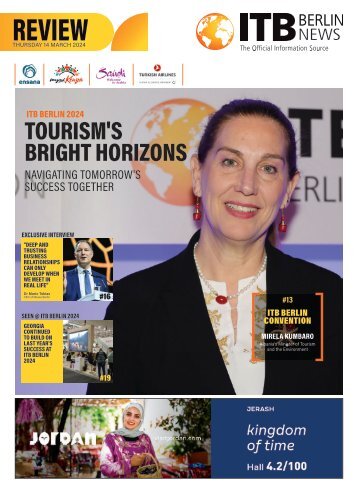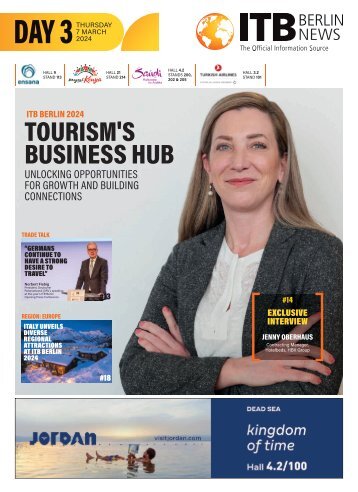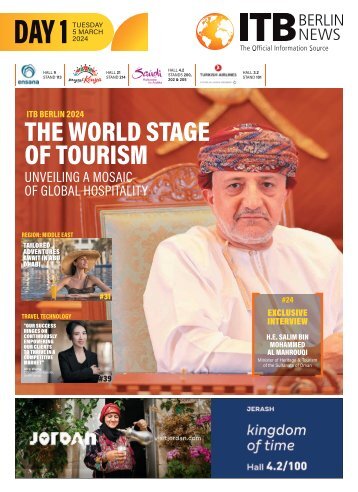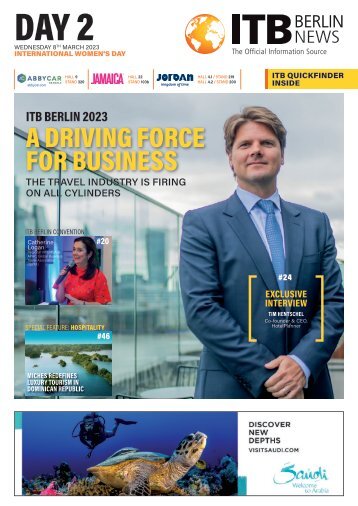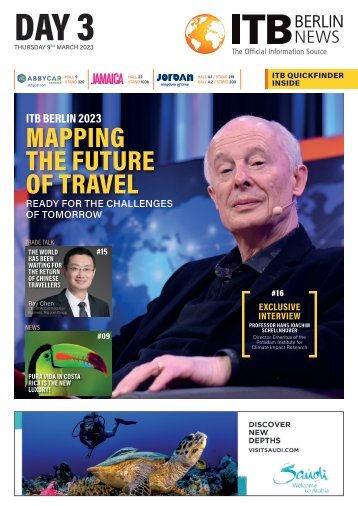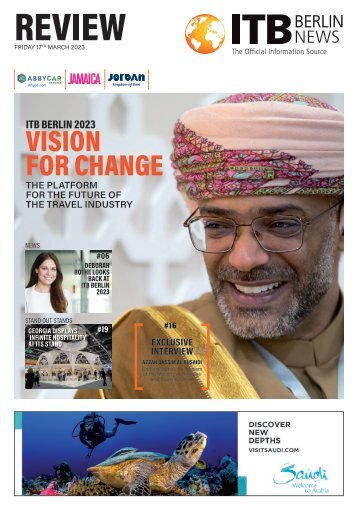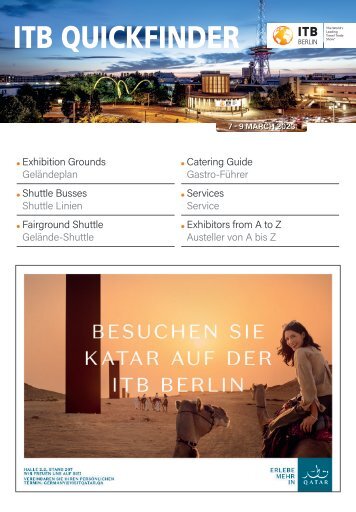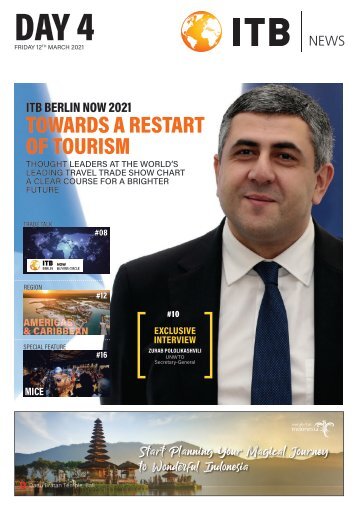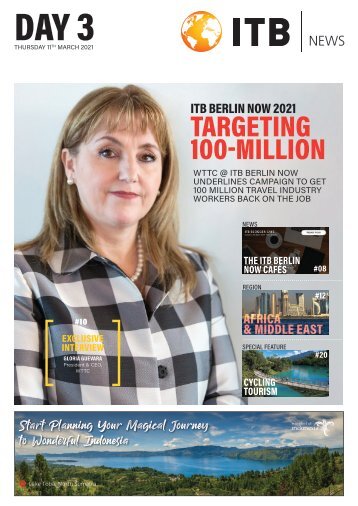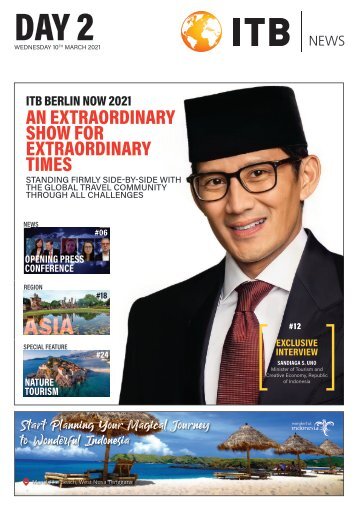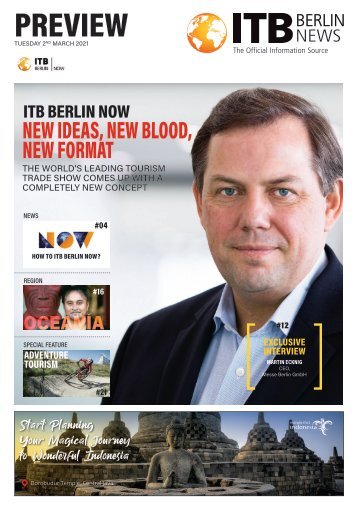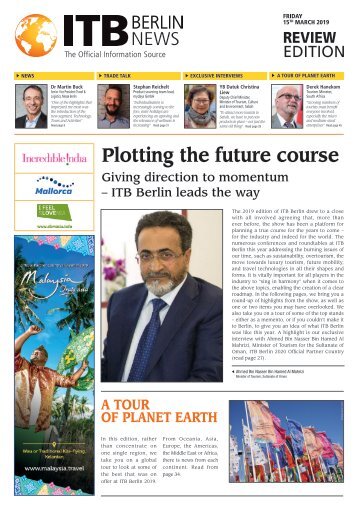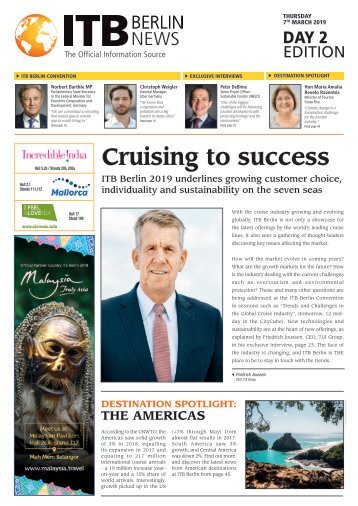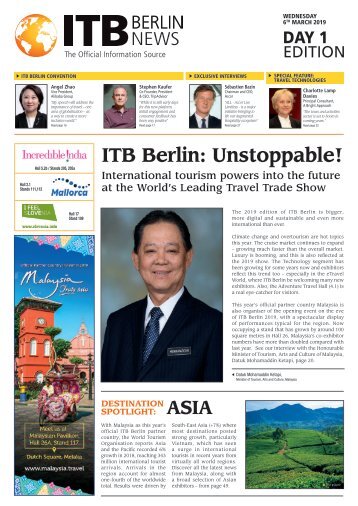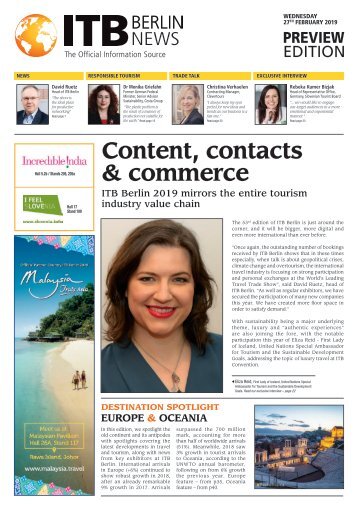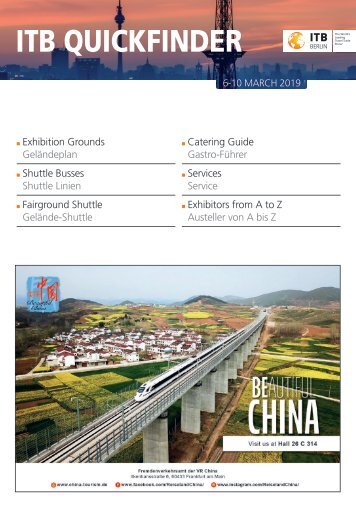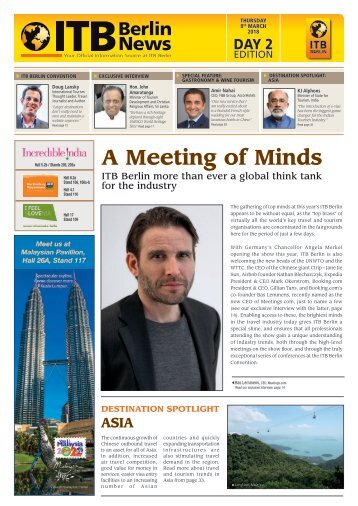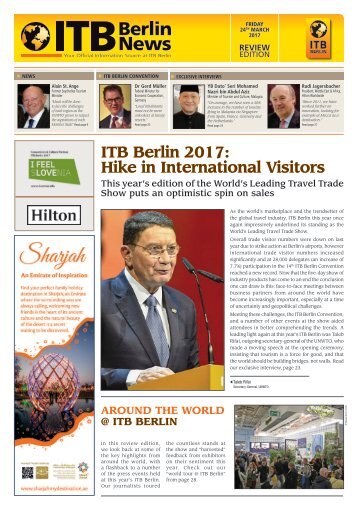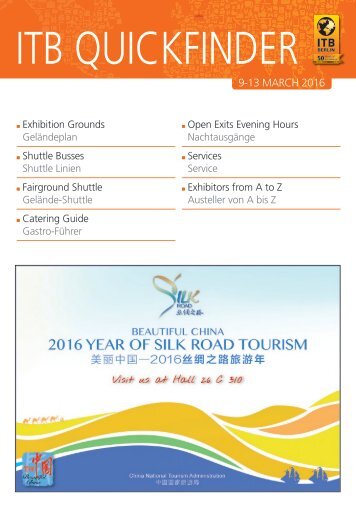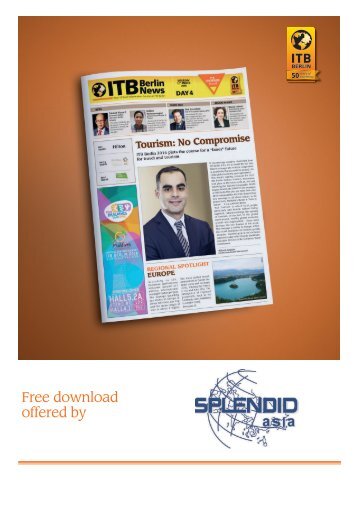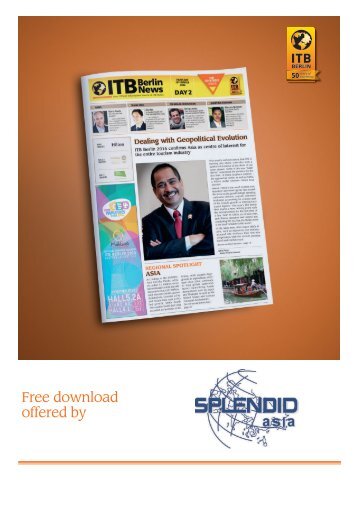
ITB Berlin News - Day 4
- Text
- Hotels
- Tourism
- Resort
- Tours
- Resorts
- Berlin
- Exhibitors
- Halle
- Tourismus
- Aussteller
18 SPECIAL FEATURE
18 SPECIAL FEATURE GASTRONOMY & WINE TOURISM © Hoshinoya Karuizawa - Japan National Tourism Indonesian Flavours Ripe For Discovery Culinary tourism gets new push Xkuliner Bandung © Ministry of Culture, Tourism, Republic of Indonesia Japan’s Culinary Treasures Promoting one of the world’s most recognised cuisines Despite the popularity of Japanese food around the world, many potential travelers to Japan do not fully appreciate the unique scope of the national culinary scene. While sushi is a central part of Japanese heritage, myriad flavors from all around the world have contributed to Japan’s robust foodie culture that is attracting culinary pioneers from far and wide. Tokyo, for example, has more stars in the prestigious Michelin Guidebook than any other city in the world. From noodles to sashimi to gourmet French cuisine, Japan has the food to satisfy the most discerning of palettes, as well as the strictest of budgets. In an effort to better exploit the potential of culinary travel in the land of the rising sun, the Japan National Tourist Organisation has initiated a campaign to promote Japanese gastronomy tourism. This includes ITB BERLIN NEWS • Saturday 12 th March 2016 highlighting Japan’s best restaurants or street foods on the JNTO website and other media. While every town and village has its own distinctive cuisine, an especial focus for culinary travelers will be Tokyo, which is arguably the foodie capital of the world. “Tokyo offers diverse activities through which to explore our food culture,” says Chieto Misumi, Director of the Tourism Promotion Department at the Tokyo Convention & Visitors Bureau. “Travellers can visit the famous Fish Market in Tsukiji and taste original Tokyo Edo-Mai sushis. They are also a few cooking schools providing courses in English to visitors to learn how to create sushi or Japanese desserts.” The ancient city of Kyoto prefers to promote its older culinary traditions. According to Maiko Sakurai, who works at the Kyoto Convention TOKYO, FOR EXAMPLE, HAS MORE STARS IN THE PRESTIGIOUS MICHELIN GUIDEBOOK THAN ANY OTHER CITY IN THE WORLD. Bureau, foreign travellers increasingly come to the city, not only to visit its stunning temples, but to learn the art of serving tea. The “Sharing-Kyoto” website is also helping travellers looking to discovering the best places for sushi, ramen, soba and udon (noodles), tempura, curries or tonkatsu, a breaded, deep-fried pork cutlet. Hall 26A / Stand 129 Food culture is a central part of life across the Indonesian archipelago’s 14,000 islands. The Southeast Asian nation produces many specialty foods and iconic dishes that have strong recognition around the world. Nonetheless, culinary tourism is a relatively fledgling market in Indonesia. A new initiative by the Indonesian Ministry of Tourism aims to change that. “Indonesia’s soul can be explored and discovered through our food. We now need to promote it systematically as part of the tourist experience in our country”, explained Nia Niscaya, Director of International Tourism Promotion at the Indonesian Ministry of Tourism, at ITB Berlin. “We Indonesians always assume that foreigners will know our food well. But we now understand that we should also be more proactive in highlighting our culinary diversity.” The ministry is hoping to promote destinations through famous local dishes including nasi goreng, a local version of fried rice, and rending, a meat marinated in coconut milk and spices that was voted one the world’s most delicious foods by a CNN International online poll. “Rendang originated from West Sumatra and there is an annual Rendang festival being organised in the West Sumatra capital, Padang. Such an event could in fact help raise more awareness for the province. Many cities have their own culinary specials which could be the base of our gastronomy tours”, says Niscaya. Coffee culture is also taking off all around the world and with visitors to Indonesia able to explore coffee plantations in North Sumatra, Central Java or in Bali, and to sample some robust Java bean brews, the country is wellplaced to attract coffee connoisseurs from the four corners. The Losari Coffee Plantation Resort and Spa, for example, has been become a highly popular destination by combining culinary travel with responsible tourism, which includes the provision of education and income to surrounding communities. Hall 26A / Stand 122, 123 www.itb-berlin-news.com
GASTRONOMY & WINE TOURISM 19 ADVERTORIAL The Grape Crusher statue in southern Napa American Vino Veritas A tour of the most delectable wine regions of the USA The U.S. ranks sixth in the world with 5.8% of the world’s vineyard acreage. California is America’s most famous wine region, And with 4285 wineries, it’s the largest. But it’s not the only region. The truth is there are at least 75 other officially designated winegrowing areas and more than 6200 other wineries in USA—areas that wineloving tourists should drink up. Colorado… it brings up memories of skiing, whitewater kayaking, climbing and trekking. This U.S. state known for its great outdoors adventures also puts its dramatic outdoors to vinicultural use. Vineyards on the Rockies’ Western Slope are some of the best places outside of California for a winery tour. Ones around towns like Palisade and Grand Junction are family-owned, lacking the pretensions of some other wine areas. Several state parks, including Grand Mesa National Forest and Little Bookcliffs Wild Horse Range, are within driving distance. Washington State has its Columbia Valley. With more than 80 wineries, it’s a great choice for tourists who want to explore vineyards down small country roads. An even more rural grapegrowing area can be found in the Walla Walla Valley, credited with some of the West Coast’s best red wines. While New York might bring thoughts of skyscraper-full Manhattan, the NY state is almost the size of France. It’s a green state and its Finger Lakes region counts more than 11,000 acres (44.5 sq, km) of vineyards. Nearly 100 wineries operate around Seneca and Cayuga lakes. Well-organized “wine trails” take tourists through beautiful hills, rivers and lakes. South of America’s Niagara Falls, Western New York is also a wine region. New York wine is not all “upstate” as the state’s southernmost wine region is next to New York City: Long Island with 60 vineyards. Texas is not just cattle, oil and gas, and Dallasstyle ranches. Hill Country with its wide-open spaces, forested hills and rugged landscapes stretches through the heart of Texas between major cities like San Antonio and Austin. The historic and charming town of Fredricksburg can be the starting point for a tour along U.S. Highway 290 with a dozen wineries. It’s also home to horsebackriding tours, cave tours and river rafting. Lake Erie wine country follows along the shores of one of America’s “Great Lakes” into the states of Ohio, Pennsylvania and western New York. The Lake Erie Wine Trail, sometimes called the Chautauqua Wine Trail, grows a variety of grapes, though white wines prevail. With 23 wineries on the eastern-most shore, enthusiasts can travel west to find more in western shores in Ohio. In Oregon, the Willamette Valley at the base of Coast Range stretches from just south of the city of Eugene to the Oregon-Washington border. Willamette wineries are mainly known for their pinots (grigio and noir), but there is plenty of variety in the more than 250 wineries. Berry farms and hazelnut fields are also found in the valley. Virginia’s Loudon County is just outside of Washington, D.C., and its wineries sit amid some noteworthy historic sites such as presidential estates and Civil War battlefields. Loudon boasts scenic horse-riding trails, farmers’ markets and farm restaurants, and even canoeing and kayaking on the Potomac River. Wineries have gathered in several “clusters.” Tour companies might use cars and buses, but green-minded travelers can even follow the Loudon wine trail on bicycles. Also in Virginia, you can find the “Birthplace of American Wine.” The Monticello Wine Trail, inspired by Thomas Jefferson’s vision of winemaking, offers 30 wineries. Its Rivanna River was once called the “Rhine of America” for its wine production. Hall 2.1 / Stand 480 WELL- ORGANIZED “WINE TRAILS” TAKE TOURISTS THROUGH BEAUTIFUL HILLS, RIVERS AND LAKES. ITB BERLIN NEWS • Saturday 12 th March 2016
- Page 1 and 2: Free download offered by
- Page 3: SATURDAY 12 th MARCH 2016 DAY 4 ITB
- Page 8 and 9: 8 NEWS FROM ‘66TO‘16 50 gloriou
- Page 10 and 11: 10 NEWS ADVERTORIAL New Openings Fo
- Page 13: TRADE TALK 13 Going Direct ETOA add
- Page 16 and 17: 16 EXCLUSIVE INTERVIEW © James Sou
- Page 20 and 21: 20 SPECIAL FEATURE ADVERTORIAL GAST
- Page 22 and 23: 22 SPECIAL FEATURE ADVERTORIAL EVEN
- Page 24 and 25: 24 SPECIAL FEATURE ADVERTORIAL WELN
- Page 26 and 27: 26 SPECIAL FEATURE ADVERTORIAL LGBT
- Page 28 and 29: 28 REGION EUROPE Serbia Courts Inte
- Page 30 and 31: 30 REGION EUROPE REGIONAL TOURISM G
- Page 32: 32 WHERE TO GO IN Berlin Restaurant
- Page 36 and 37: EXHIBITION GROUNDS GELÄNDEPLAN Hal
- Page 38 and 39: SHUTTLE BUSSES & FAIRGROUND SHUTTLE
- Page 40 and 41: SERVICES SERVICE Airports Informati
- Page 42 and 43: EXHIBITORS FROM A TO Z / AUSTELLER
- Page 44 and 45: EXHIBITORS FROM A TO Z / AUSTELLER
- Page 46 and 47: EXHIBITORS FROM A TO Z / AUSTELLER
- Page 48 and 49: EXHIBITORS FROM A TO Z / AUSTELLER
- Page 50 and 51: EXHIBITORS FROM A TO Z / AUSTELLER
- Page 52 and 53: EXHIBITORS FROM A TO Z / AUSTELLER
- Page 54 and 55: EXHIBITORS FROM A TO Z / AUSTELLER
- Page 56 and 57: EXHIBITORS FROM A TO Z / AUSTELLER
- Page 58 and 59: EXHIBITORS FROM A TO Z / AUSTELLER
- Page 60 and 61: EXHIBITORS FROM A TO Z / AUSTELLER
- Page 62 and 63: EXHIBITORS FROM A TO Z / AUSTELLER
- Page 64 and 65: EXHIBITORS FROM A TO Z / AUSTELLER
Inappropriate
Loading...
Mail this publication
Loading...
Embed
Loading...
